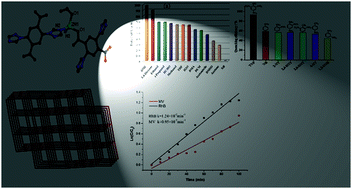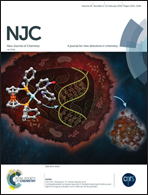A new Zn(ii) metal–organic framework having 3D CdSO4 topology as luminescent sensor and photocatalyst for degradation of organic dyes†
Abstract
A new Zn(II) metal–organic framework, formulated as {[Zn(L)]·2.7 DMF} (1), was synthesized using a multidentate ligand 1,4-bis(triazol-1-yl)terephthalic acid (H2L). The MOF 1 adopts 3D uninodal 4-c CdSO4 topology and behaves as a luminescent chemosensor for highly selective and sensitive detection of Fe3+ and nitro-aromatics, particularly 2,4,6-trinitrophenol (TNP). In addition, the thermal stability, UV/Vis diffuse-reflection spectra and photocatalytic behaviors of 1 against organic dyes have also been investigated. The possible mechanism associated with the alleviation in the emission intensity of 1 in the presence of nitro-aromatic compounds were addressed by theoretical calculations. In addition, the photocatalytic activity of 1 against organic dyes was addressed using density of states (DOS) calculations.



 Please wait while we load your content...
Please wait while we load your content...